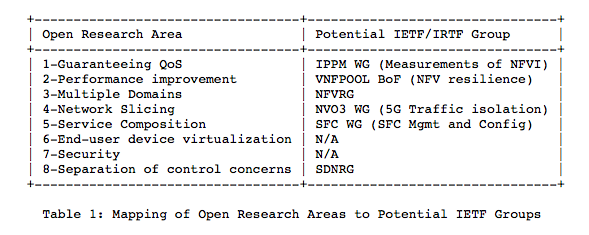In the las few days, IETF, ETSI and 5G PPP have provided important progress reports of their 5G activities. ETSI work to evolve today’s (IP) networking protocols towards 5G saw the first Next Generation Protocols specification completed. IETF released 3 new documents looking at network slicing, virtualization and ID location splits in 5G Networks. 5G PPP issued its 2016 annual journal with an update of the 17 programs under EU’s Horizon 2020 and views of technology and spectrum for 5G.
In IETF, There Are New Proposals for Virtualization, ID Split and Network Slicing in 5G: Telefonica, SigFox and InterDigital are the authors of the latest IRTF network virtualization document. The document outlines how network virtualization is a more complex problem than cloud computing, and follows with a list of current research challenges like guaranteeing QoS, performance improvement, multi-domain support, network slicing, service composition, device virtualization, privacy and security. The major outcome of the document is a proposal to IETF/IRTF to solve these challenges mapping the work to be done to potential IETF groups (see Table 1.)
Another recently released IETF document addresses the ID location split in 5G networks. According to Huawei, authoring the document, this is needed because currently the IP (Internet Protocol) address indicates both the identity and location of the end host. This addressing scheme doesn’t support mobility and multiple accesses naturally. It is also inefficient in terms of route validity (referring to route aggregation with locator), scalability, and security; an additional issue is that the communication message is transmitted by any address, and is not affected the identifier of both ends of the communication. To tackle these issues, a generic network scheme based on ID / Locator separate architecture is proposed. It satisfies the following requirements of future networks:
- Ubiquitous mobility: the identifier is independent from network location;
- Low latency: select any optimal path, not subject to IP network segments;
- High reliability: one communication identifier mapped to multi-address/transmission paths;
- High-bandwidth: multi-address, make full use of a variety of access technologies;
- Low-power and low complexity network, mass IOT device access and small data packet message transmission: transmission, signaling mechanism are simplified.
Last, an IETF Draft proposal from Korea, describes an architecture for real view of deployment of mobility and multicast functions in 5G core network. The proposal assumes that in the 5G era, the mobile network functions and mobile services could be provided on demand using NFV and network slicing. The document outlines the architecture of delivering the mobility and multicast services over 5G core network using NFV and network slicing. The mobility and multicast are delivered to customers depending on their type of traffic that they are going to request or mobile operator’s specific use cases. The proposal borrows from distributed mobility management deployment and management and orchestration framework (MANO) of NFV.
ETSI’s Next Generation Protocol Group Released GS NGP 001: ETSI NGP ISG (Next Generation Protocol) released a document with the key scenarios to evolve the current Internet Protocol (IP). It contains a total of 51 use cases that reference 3GPP TR 22.891 as well as inputs from other standard bodies. The use cases address security, mobility, context-awareness, performance improvement and content enablement as well as multi-access, Internet of Things (IoT), virtualization, mobile edge computing and energy savings requirements related to protocol evolution for 5G systems. The document also compares and contrasts existing IP suite protocols with next generation networking protocol architecture proposals.
When announcing the availability of the new specification, Andy Sutton, Chairman of NGP ISG said that “Current and future use cases include 4K videos on various devices, massive IoT, drone control or virtual reality…. A modernized network protocols architecture had to be triggered and this is why NGP ISG was created.”
The European 5G PPP Journal 2016 Issue: 5G PPP released this week their annual 5G Journal with a progress update of the 17 R&D projects funded under EU’s Horizon 2020 program. The journal also reviews the four “industry vertical” use cases of 5G: automotive, energy, factories and e-Health, and also addresses technical developments in radio access network design, NFV network slicing, system architecture, security, energy efficiency.
On the subject of spectrum, the journal makes three important points:
- The bands with primary allocations to 5G mobile service are 24.25-27.5 GHz – 37-40.5 GHz – 42.5-43.5 GHz – 45.5-47 GHz – 47.2-50.2 GHz – 50.4-52.6 GHz – 66-76 GHz – 81-86 GHz
- The candidate bands for additional allocations are 31.8-33.4 GHz – 40.5-42.5 GHz – 47-47.2 GHz
- There are some 5G PPP programs looking at LSA/ASA spectrum sharing schemes aiming at trials in some markets.
Sources: IETF, ETSI, 5G PPP
COPYRIGHT © 2016 5G-MAGAZINE.COM


